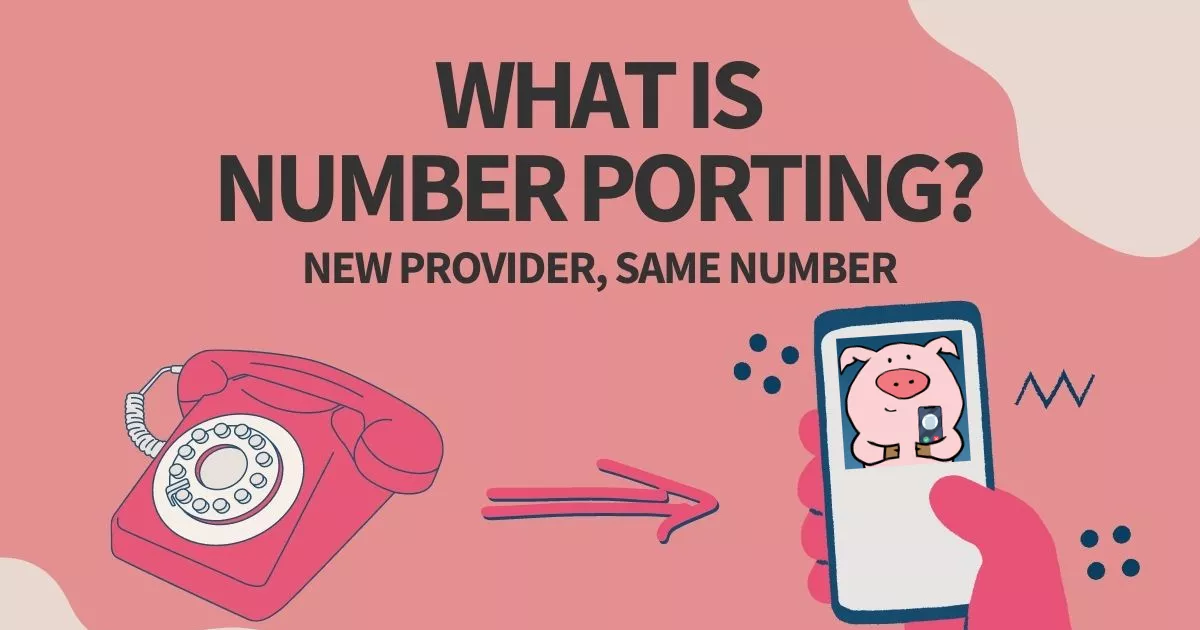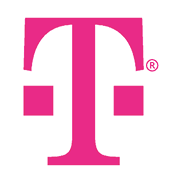If you’re switching providers, you generally don’t have to let go of the phone number you’ve had forever (including landline phone numbers) — if you know what to do, that is.
That’s right, no more “New phone, who dis?”
And that’s all thanks to number porting. If you’re switching carriers and want to know how to save your original number with your new phone provider or how to find a new phone number and transfer it to your preferred service provider, read on.
Porting 101 – Table of Contents
- What is Number Porting
- How to Switch / Port Your Number
- How Long Does It Take to Transfer My Number?
- Pros and Cons of Phone Number Porting
- Terms You Might Need to Know
What is porting a phone number?
Let’s keep things simple with a quick definition:
Number Porting: Transferring your phone number from one service provider to a different service provider.
That’s all porting means!
There are countless reasons to port a number, such as:
- Changing carriers or service providers
- Saving your old business phone number because you’ve printed it on all your marketing materials
- Relocating and you want a local number to establish community credibility for yourself or your new business
- Keeping your prior number to protect your existing associated accounts, etc.
- Better protecting your privacy with an additional phone number
Whatever your reason for porting your number, we’ve got some tips to help you navigate moving a phone number to a different provider, carrier or service.
Here’s an example: let’s say your original phone number is with NumberBarn, but you want to switch over to “Bumber-Narn” (our arch-nemesis).
To keep your original telephone number, you have to port (aka transfer) your active number from NumberBarn over to “Bumber-Narn.” After a short transfer period, your number will no longer be with NumberBarn, and you’ll pay your new provider instead. Same number, different provider!
How to transfer your number to a new phone
Porting your number is a fairly straightforward process, but can still be a bit tricky.
If you’re more of a visual learner and want to port your number to NumberBarn, here’s a short video explaining how to do that:
Here’s how to port your number
1. First, you need to contact the company you want to transfer your number to.
I know, nobody likes contacting companies. But sometimes it’s necessary. The biggest and most crucial reason to contact the company you would like to port to, is to first verify if they can accept the number you intend to port (more on that shortly). Beyond that reason, (as you’ll find out after you click on any of the links below), here’s a list of items you’ll probably need to provide to initiate the port, either upfront, or down the line (no pun intended):
- The phone number you are porting
- Your account number and PIN#/Passcode (when porting a wireless number)
- Your physical address (no P.O. Boxes are typically allowed)
- Phone call to authorize port OR signed Letter of Authorization (LOA)
- A copy of your phone bill (“COB”) from your current provider dated within the last 30 business days (It’s super important the info you submit during your sign-up matches the information your old provider has on file, because any discrepancies can really delay the number porting process.)
While each carrier has plenty of specific info on how to port your number to them, it might still be easier to call them. Regardless, we’ve compiled all their online links below:
Note: If you’re porting away from NumberBarn, there may be other information you need to provide. You can find what information that is in our article here (and how to find it in your account).
2. Double-check for any contracts or additional services that may affect porting.
Let’s say your current mobile carrier is AT&T and you wish to switch to NumberBarn. But if you also have internet and cable with AT&T, your port might not be able to go through. Or worse: those services will be canceled without you knowing, and you suddenly won’t have internet anymore.
Call your current provider to make sure you don’t have additional services with them and if so, what you need to do to make sure your port goes through successfully and stress-free.
3. Don’t cancel your previous service until you’ve completed your port.
For a phone number to successfully port, it has to stay “active” during the port process. Don’t worry, there shouldn’t be any interruption in your ability to send and receive phone calls or text messages from that number during the porting process as long as the number is still active. You can cancel with your previous carrier once you receive a notification of completed port from your new service.
How long does it take to transfer my number?
On average, transferring a phone number takes 3-10 business days. But it can also be as little as a few hours to as long as a month!
Why such a wide range? It’s complicated, but the most common factor has to do with porting wired to wireless numbers (and vice versa), which can take a little while.
Ultimately, each carrier processes its porting requests at different times and at different speeds.
We recommend reaching out to the new carrier before requesting your port and asking what their timeline will look like for your specific number porting request(s).
| Service provider | Estimated time to port a number |
|---|---|
| NumberBarn | 3-10 days |
| AT&T Mobile | Minutes to 5 business days |
| Landline | 5 to 7 business days |
| Google Voice | Up to 48 hours |
| Grasshopper | Up to 2 weeks |
| Mint Mobile | Mobile: Up to 48 hours |
| Landlines | Up to 5 business days |
| OpenPhone | US numbers: 5 to 7 business days |
| Canadian numbers | 10 to 12 business days |
| RingCentral | 15 to 30 business days |
| T-Mobile | Mobile: 10 minutes to 2 hours |
| Landline | 3 to 10 days |
| Verizon | Mobile: 4 to 24 hours |
| Landline | 2 to 4 business days |
| Vonage | Up to 10 business days |
Pros and Cons of Transferring Your Old Number
While we believe the pros greatly outweigh the cons, not all porting situations are created equally.
Pros
- You may get to keep your old wireless / landline number
- This is especially good if your number is highly valuable, or if it was tied to a landline, which are generally very stuck-to-their-original-location numbers!
- You could choose your digits elsewhere, then move them to your new phone provider
- You don’t have to stick with the number that you’re assigned by your new provider! You can look for the number of your dreams somewhere else, like an unforgettable vanity number, then port it out to your new provider.
- It can protect you from future identity theft due to “number recycling”
- Normally when you switch providers, you receive a new phone number and lose your old one, your old number typically gets recycled, which a study by Princeton University found can be the starting point for people to sneak in and commit identity fraud!
- On that note, your old number may be connected to many of your important accounts, like bank accounts, etc. Keeping that number can be beneficial for authentication purposes and also for the convenience of not needing to change your phone number in countless miscellaneous accounts.
- If you’re moving to a different country, you might be able to keep your old number and avoid long-distance calls
- Port and park your landline phone number and/or cellphone number with NumberBarn. From there, forward all calls to your new, international number. (For example, NumberBarn works with over 40 countries, and while every country has its own international rates, NumberBarn has extensive options for international forwarding.)
- Sentimentality!
- Your established number is just so you. And it’s annoying to have to update every person and document on the planet. This is especially common with that decades-old landline your parents may still use. You have the option of keeping that number and porting it to the carrier at your new residence, or cutting the landline bills altogether by porting the number to NumberBarn. You can park it or forward calls to your personal cell phone number or new landline. Additionally, you can often port the landline number directly to a wireless provider.
Cons
- It may not be possible, depending on your number and carriers
- This is due to the magic of “rate centers” (more on those below), which are the geographic locations any given phone number is supported within. As frustrating as that may be, there is still a way to work around losing your number. You can port your number to NumberBarn and set your account to forward all calls to your new number.
- The Process Can Take a While
- The porting process can take an average 3-10 business days, but in the instance where you’re porting a wireless number to a wireline number (and vice versa), it could take as long as a month, or more.
Bonus Terms You Might Come Across When Transferring Your Number
As you go through the porting process, you may come across some unfamiliar terms. Just in case, here’s a little cheat sheet.
Rate Center
You’ve heard of local and long-distance calling, right? A “rate center” is what determines whether a phone call is local or long-distance. It’s the literal geographical area used by a Local Exchange Carrier (LEC) that defines the boundaries for local calling, billing and assigning of area codes.
A rate center may come up during the transfer process because it’s one of the reasons a provider may not accept a port. As we mentioned earlier, if you don’t check with your preferred carrier before purchasing a new phone number, your port request could be rejected if your new carrier can’t service the area.
(Don’t worry, if you’re porting to or from NumberBarn, we’ll walk you through all your options without expecting you to know a single thing about the complex world of rate centers.)
Number Parking
Just like with cars, you can park your phone number!
Number parking is essentially storing your number with another service provider on a month-to-month basis. Number parking may come up if your new carrier needs time before it can take your old number.
By parking your number, you maintain ownership of your number and have it on hand for when you’re ready to port it to your new carrier. And when your carrier is ready, you can stop parking your number and port it in.
Call Forwarding
This is pretty self-explanatory: Call forwarding is the ability to forward phone calls from one phone number to a different phone number.
Let’s say you have a business and need a phone number to put on your website. You don’t want to put your personal number on the website, but don’t want to get an alternate device. You can buy a new phone number with NumberBarn, and use the call forwarding plan to allow phone calls made to your new number to forward to your personal number on your device.
Wireless vs. Wireline
Wireline (or landline as you more likely know it) uses cables, or data lines, to connect service to your home or office.
Wireless, as you might guess, doesn’t use cables or data lines, but radio frequencies to connect services to your device.
(Here’s a great article that goes in-depth on the differences between wireless and wireline, and which one might be best for you).
‘Port in’ and ‘Port out’
The provider that you are leaving is the provider you’re porting out from.
Your new provider is the one you’re porting in to!
Ready to Port?
If you ever need a new provider or a new phone number, porting is always a good idea. Why not start porting now? Even if you’re just using our port-and-park plan to store your number and protect your information.
We have plenty of other (very inexpensive!) plans you can take advantage of as well. If you have any questions along the way, check out our Help Center or reach out to our amazing customer support team who are ready to guide you to the best solution for your phone number needs!





